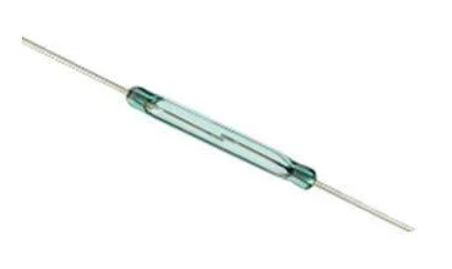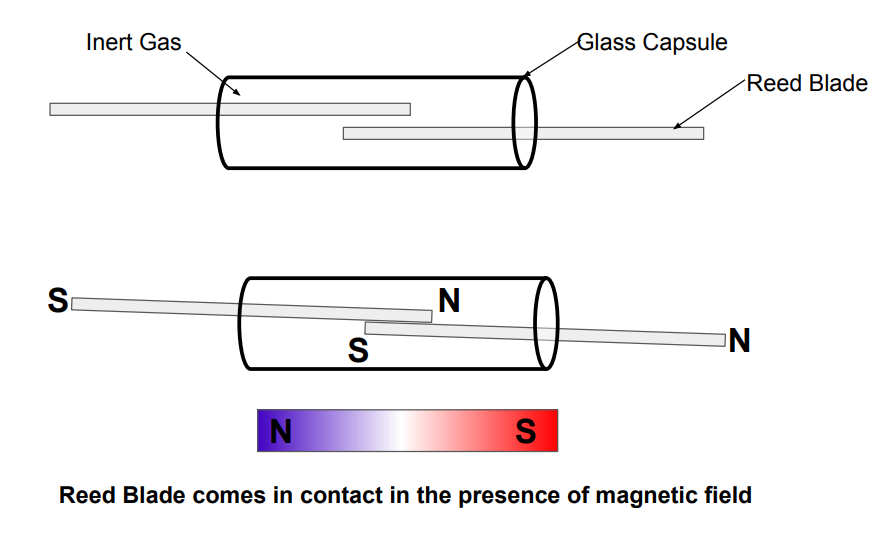A Reed switch is a type of magnetic sensor that detects the presence of the magnetic field. It consists of two reed blades hermetically sealed inside a glass capsule with electrical leads coming out of each end.

Reed magnetic sensor is a very common component in the electronics industry. You can find this component from multiple different manufacturers such as Standex Electronics, SRI Electronics, etc.
How does a Reed Switch Works?
A reed sensor consists of two ferromagnetic blades inside a hermetically sealed glass capsule filled with an inert gas such as nitrogen. The two ferromagnetic blades are at a distance of a few microns in a relaxed state.

The ferromagnetic materials get magnetized and pulled toward each other & come in contact in the presence of a magnetic field. The electric current starts flowing when ferromagnetic blades come in contact.
Types of magnetic Reed Switch
The following two types of magnetic reed switches are available in the market. Each reed sensor type has its advantages and limitations.
- Normally-Open Reed Sensor
- Normally-Closed Reed Sensor
Normally-Open Reed Switch
Reed blades are in ferrous materials such as nickel-iron alloy in the “normally open” type of reed switch. These reed blades are not in contact without a magnetic field.

Reed blades deflect to make a contact in the presence of the magnet or magnetic field. These contacts come to their original position in the absence of a magnetic field.
Normally-Closed Reed Switch
Reed blades are in magnetic materials in the “normally closed” type of reed switch. They work in the opposite way of the normally-open reed sensor.

Reed blades are in contact without a magnetic field and repel each other in the presence of a magnet. In other words, the reed blades come to their original position when we move the magnet away.
How to Implement Magnetic reed sensor in Design
You need to consider the following points during the implementation of the magnetic reed sensor in your design. The strength of your design and using the right components define the performance of the reed sensor in your product.
- What is the minimum force required to close or open the reed switch?
- Operation Frequency.
- Selection of the type of magnet, its strength, and its orientation.
- Minimum and maximum recommended distance from a reed sensor to a magnet.
- The proximity of one reed senor from other or from another magnetic field.
- Restriction in the path of the magnetic reed switch and actuation magnet.
- Safety of reed switch from external and internal mechanical forces.
1. Minimum force required to close or open the reed sensor
The following two parameters of the reed sensor determine the requirement of magnetic flux to operate the sensor.
- Pull in Value
- Drop out value
We can express the above two values in Ampere turns. Here, 1 AT is equal to 1 Gauss. Reed switch pull-in value determines its sensitivity. It is the minimum requirement of the magnetic field to operate the switch.
2. Operation Frequency
It is the maximum frequency at which a reed switch can operate. For example, if we are using a reed sensor with a maximum operating frequency of 500 Hz to calculate the rotation of a wheel. It can detect a maximum of 500 wheel rotations per minute, not more than that.
3. Selection of the type of magnet, its strength, and its orientation.
Reed switch pull-in value and the operating distance determines the selection of magnets. For example, Reed sensor with a lower pull-in value will operate first if we use two identical magnets to operate two different reed switches.
4. Recommended distance from a reed sensor to a magnet.
We can calculate the reed sensor minimum and maximum operating distance from magnet strength, reed switch pull-in, and drop-out values.
5. The proximity of one reed senor from other
Make sure in design that the magnet that is supposed to activate sensor A does not activate the other sensors if you are using multiple reed sensors and multiple magnets to operate different reed sensors.
6. Restriction in between reed switch and actuation magnet
Restrictions such as metal parts, and plastics change the magnet’s magnetic field. Therefore don’t forget to consider the impact of other components on reed sensor performance.
7. Safety of reed switch from mechanical forces
Magnetic Reed switch glass encapsulation is very fragile. Make sure the reed switch does not get damaged during manufacturing and operation.
Advantages and Limitations of Magnetic Reed Sensor
Advantages
Here is the list of advantages of magnetically operated reed sensors.
- Low Cost
- Less Power Consumption: We can select the type of reed sensor that does not consume power in normal conditions.
- Smaller in size
- Reed blades are inside a hermetically sealed glass tube. Therefore they are protected from atmospheric corrosion and safe to use in harsh & explosive environments.
- Less mechanical wear and tear.
- Immune to ESD (electrostatic discharge).
- High isolation resistance between contacts.
Limitations
Here is the list of limitations of magnetically operated reed sensors.
- These sensors are fragile because of the presence of glass tubes.
- Reed sensor does not measure the strength of the magnetic field.
- The position of the sensor wrt a magnet is critical because it is critical for product performance.
- Sensor performance degrades in the presence of ferromagnetic materials or magnets.
Applications of Magnetic Reed Sensor
Magnetic reed sensors have applications in various industries. Here is the list of applications of magnetic reed sensors.
- Security System: Door or window sensors for home automation and security uses reed sensor for detection.
- Consumer electronics products: Reed switches are used in consumer electronics products such as microwaves, washing machines, and refrigerators to ensure the door is closed for safe operation.
- Industrial Automation: Reed switches have applications in industrial machinery for operator safety. For example, reed switches are used in machine doors to ensure it is closed during operation.
- Automotive Industry: Reed sensors are used in automobiles to determine the position. For example, reed switches have applications in the electronics steering wheel, gear, brakes, and clutch to calculate their relative position and give feedback to the car ECU.
- Proximity Sensor: Reed Switches are used as proximity sensors to detect the presence of magnetic materials. Click this link to know in detail about proximity sensors.
We will keep adding more information on Reed Sensor and its applications. Please add your suggestions, comments, or questions in the comment box. Magnetoresistance Sensors and hall effect sensors are alternatives to Magnetic Reed switches.

Add a Comment